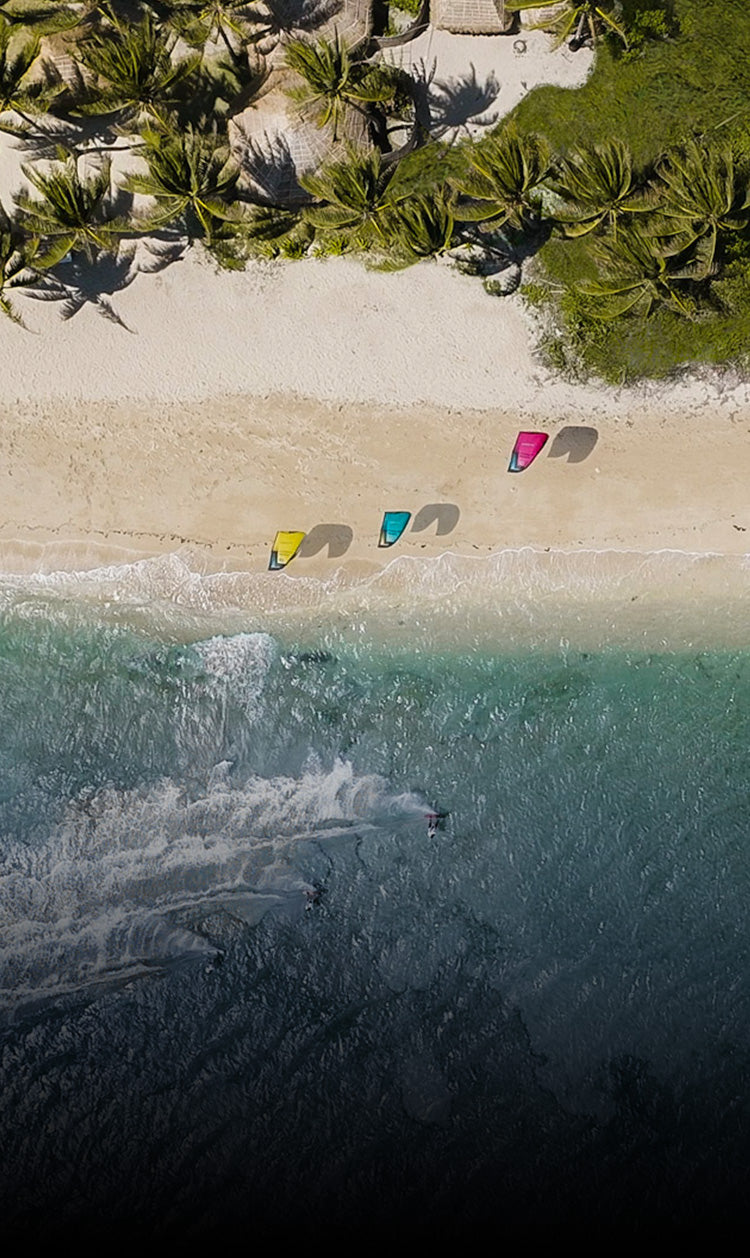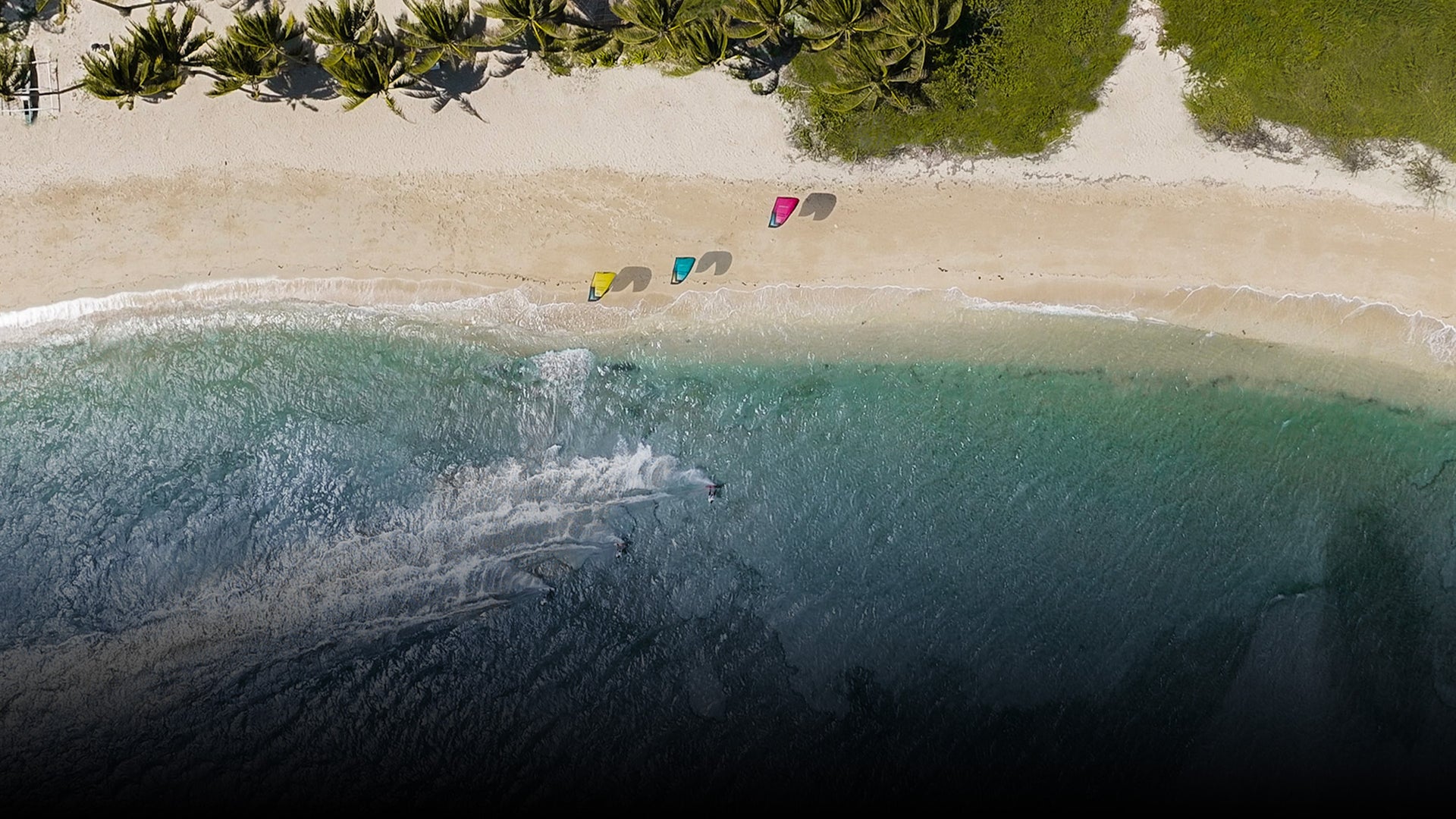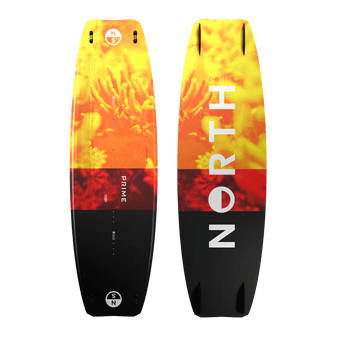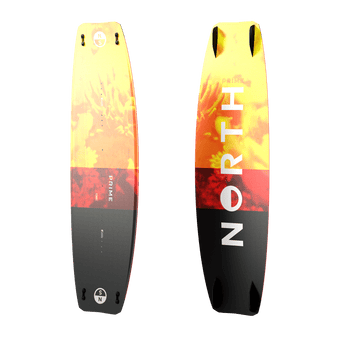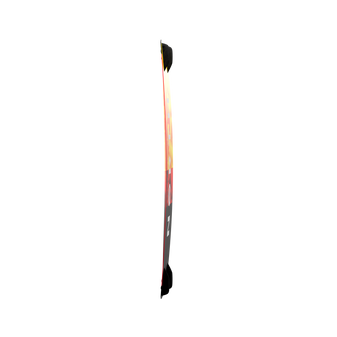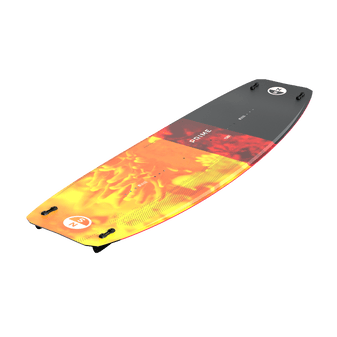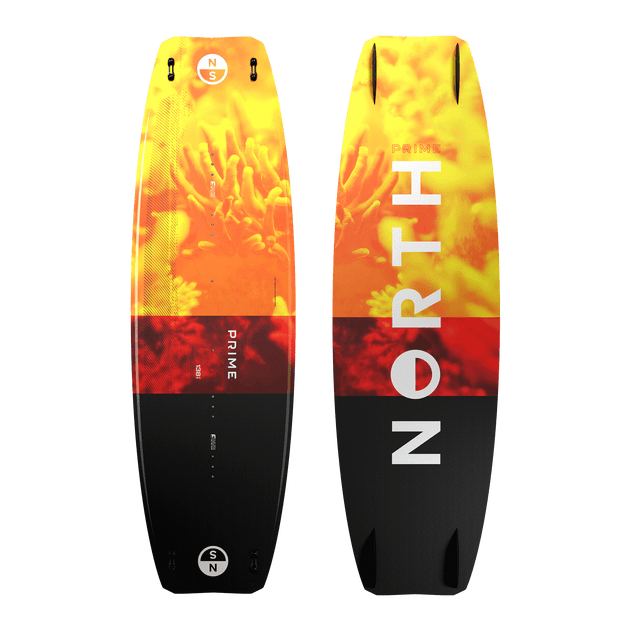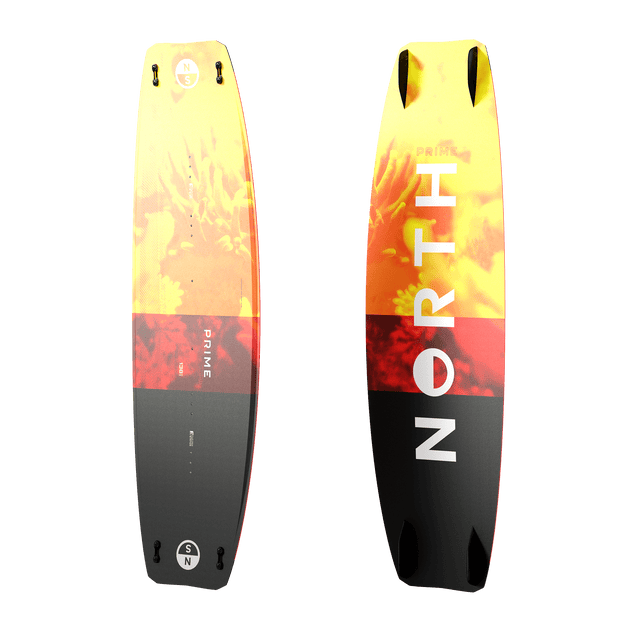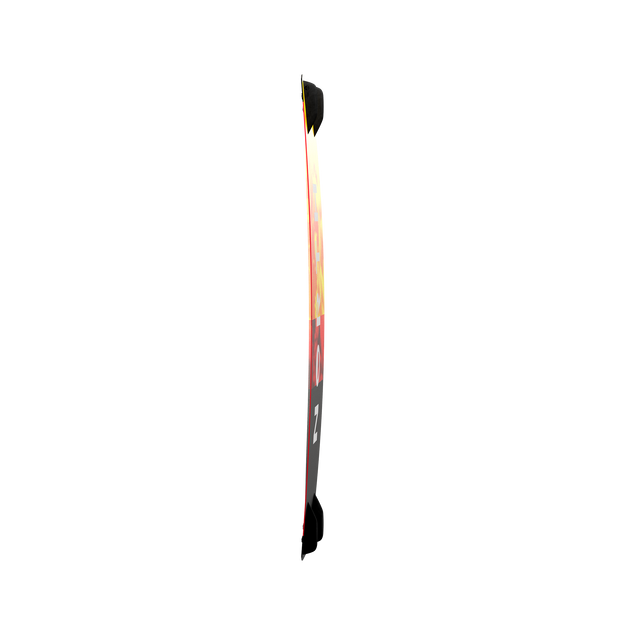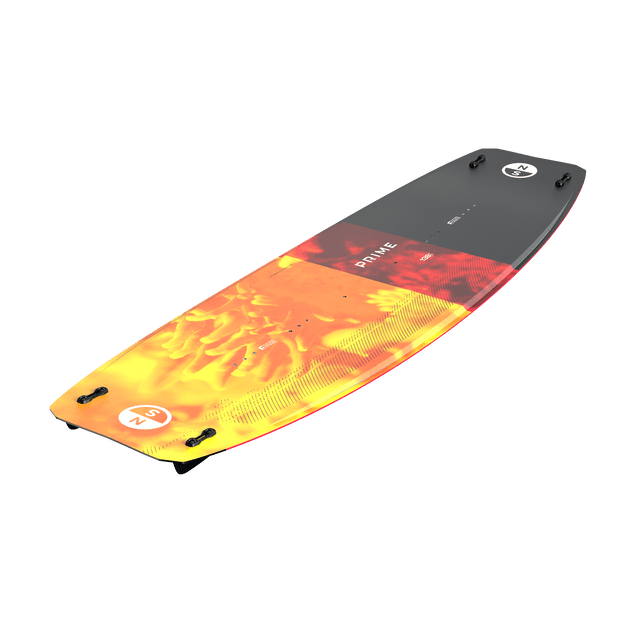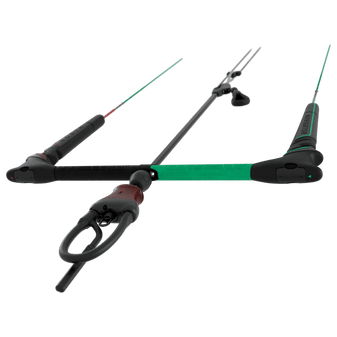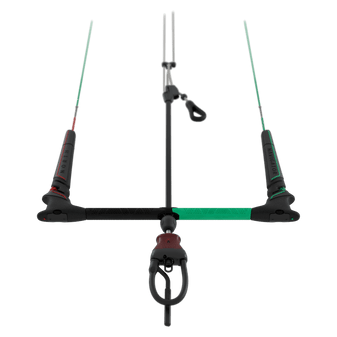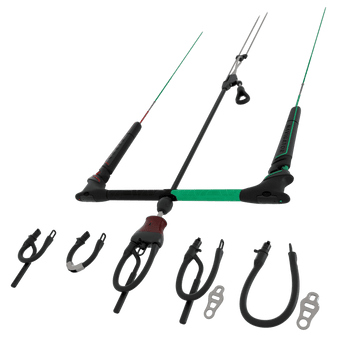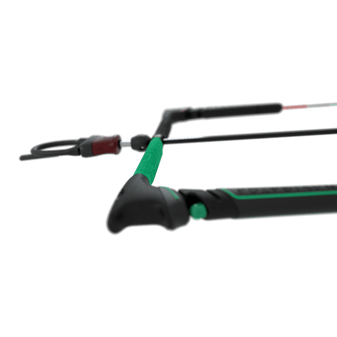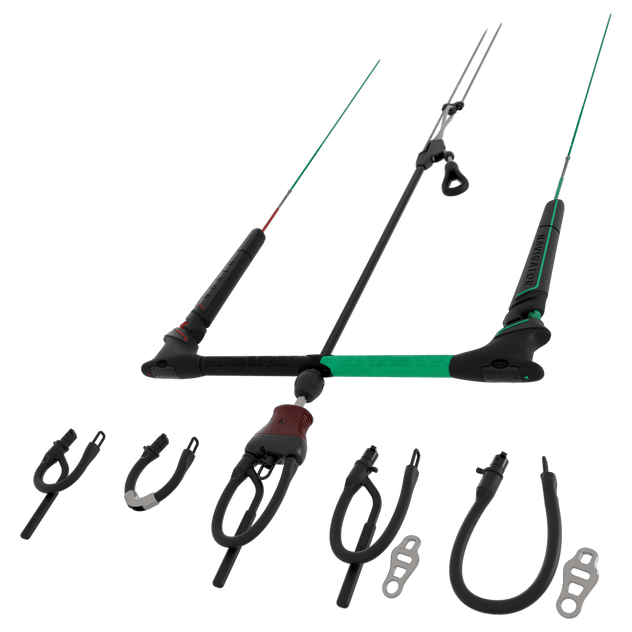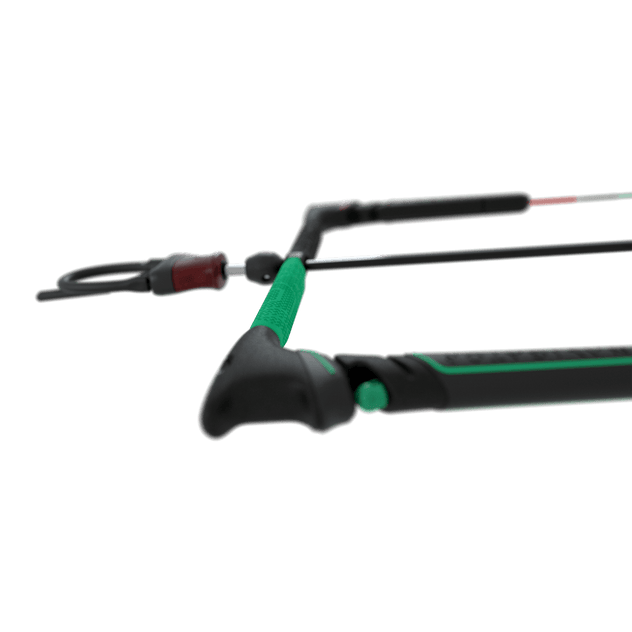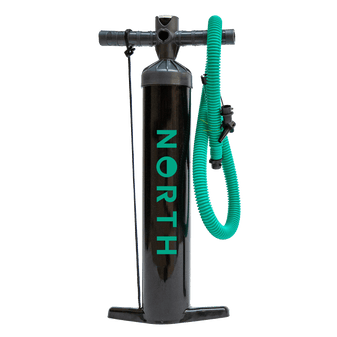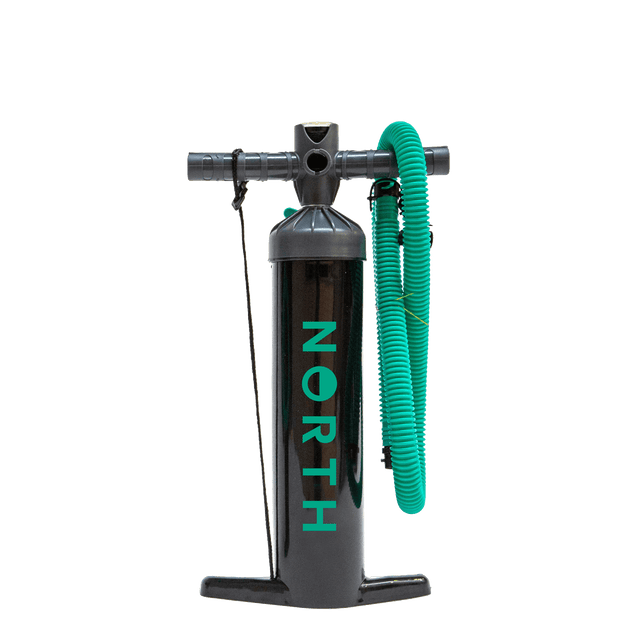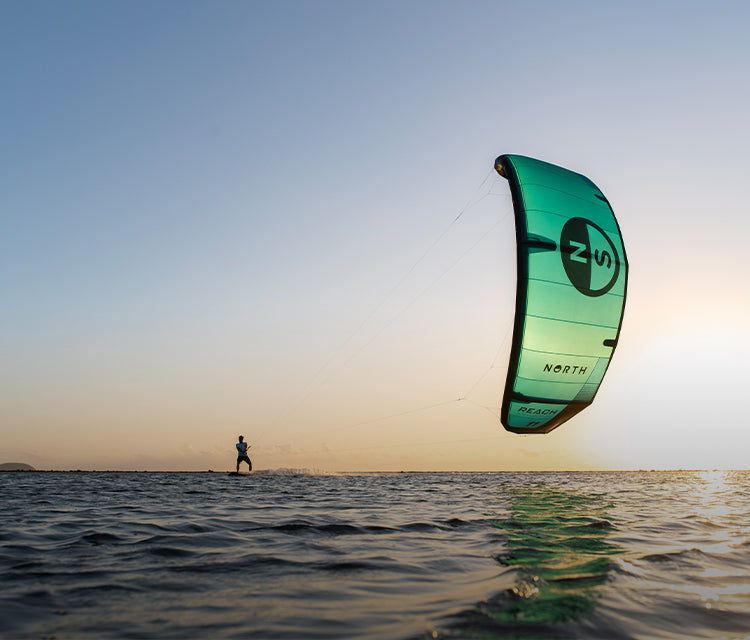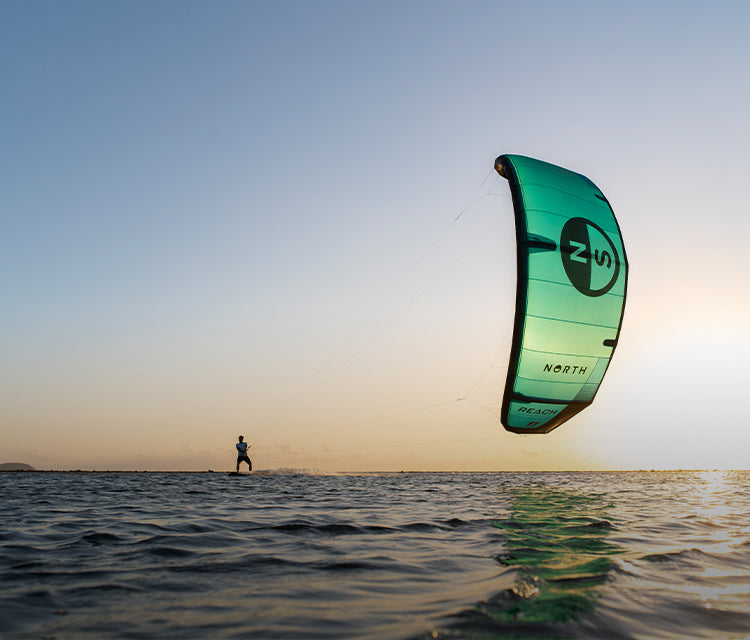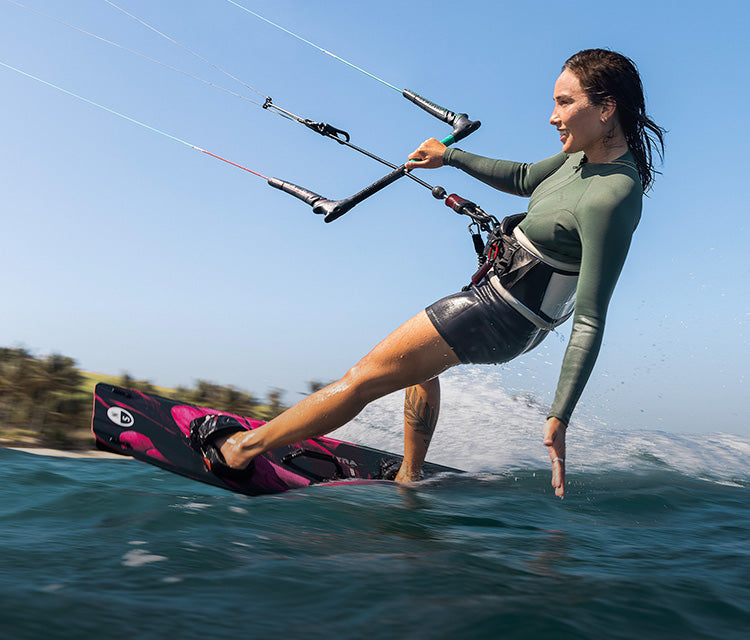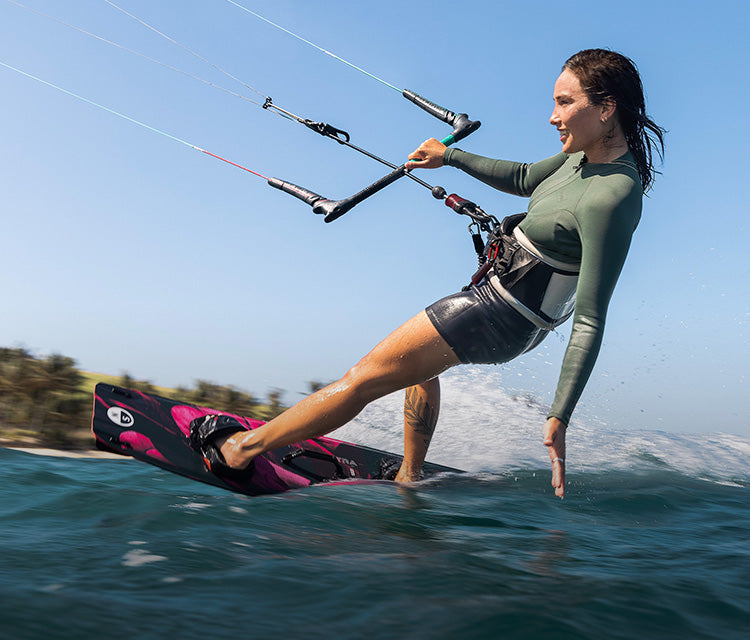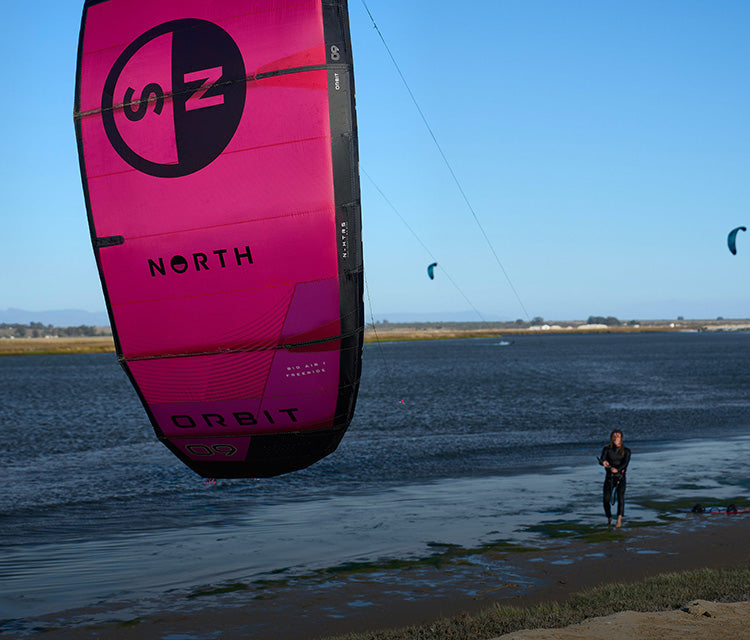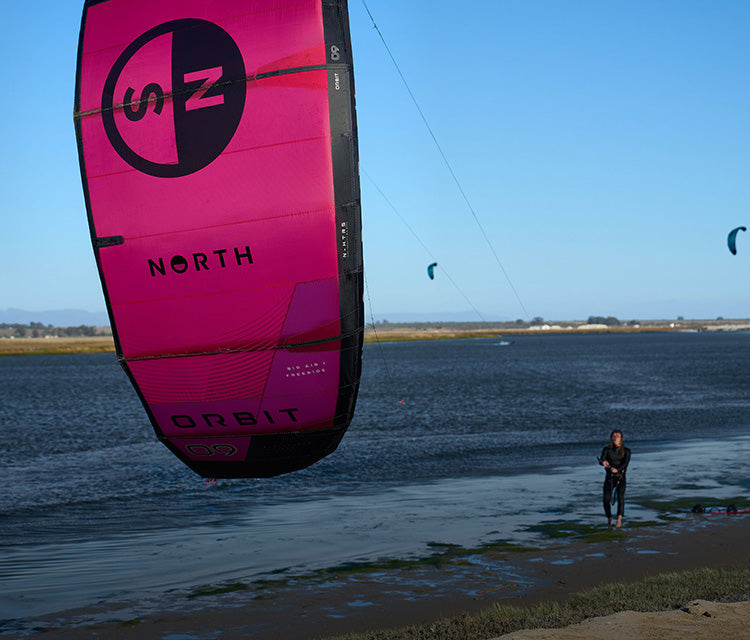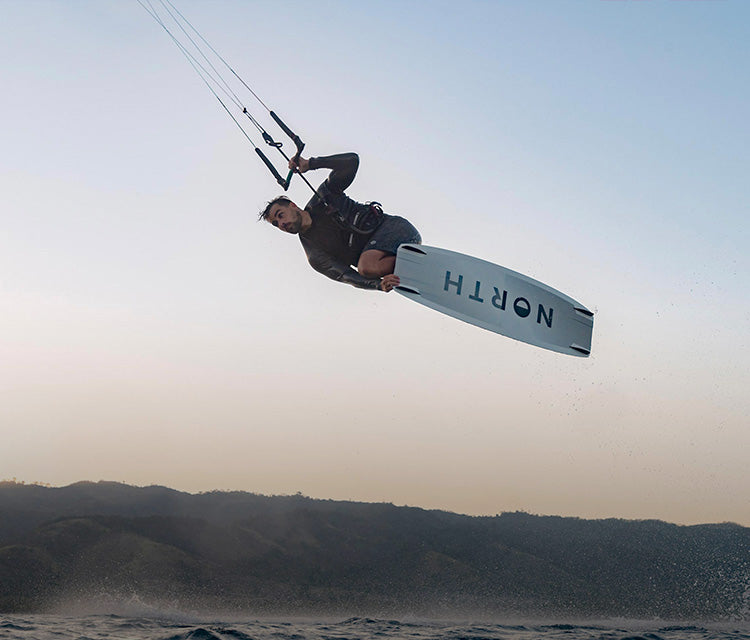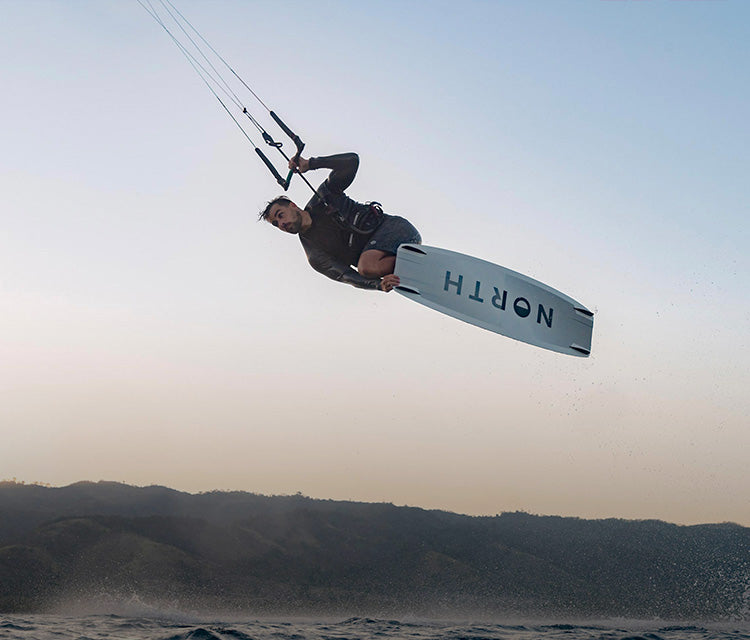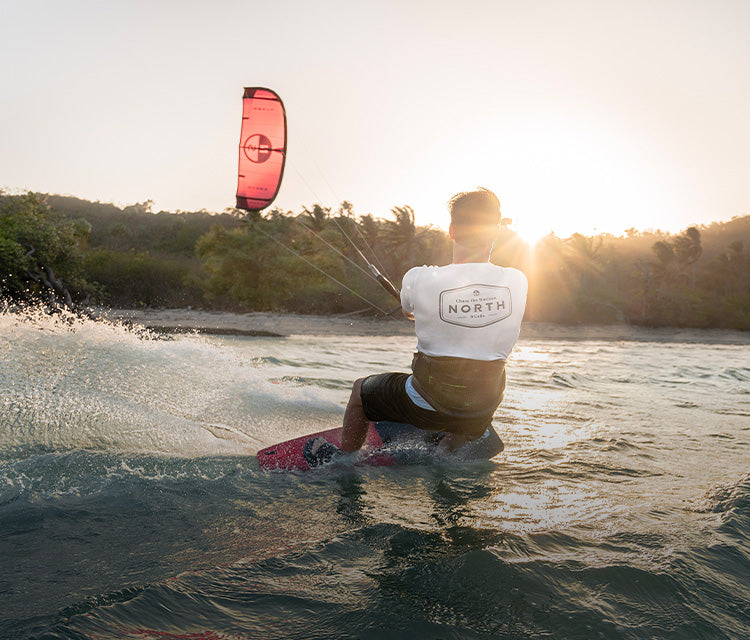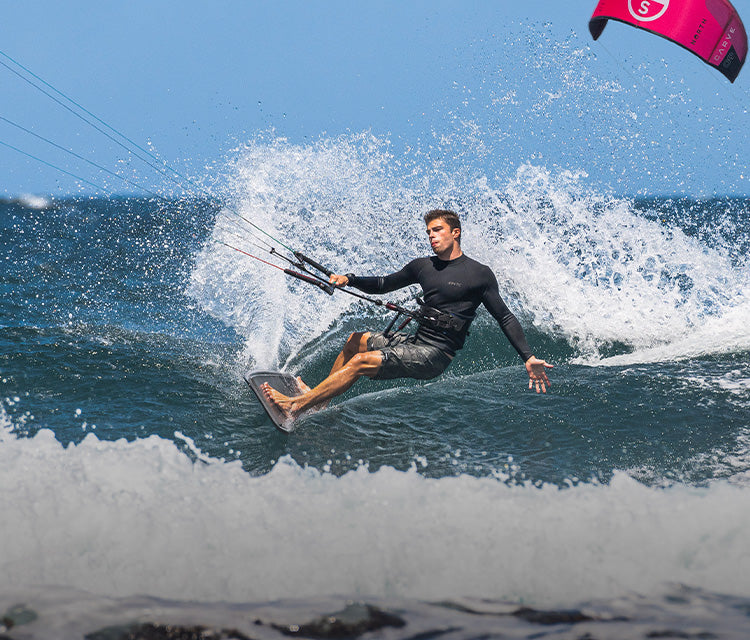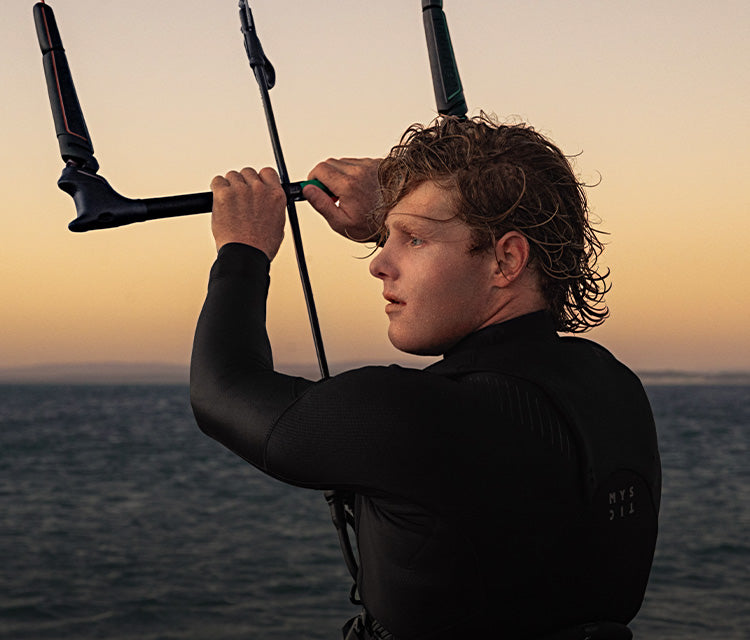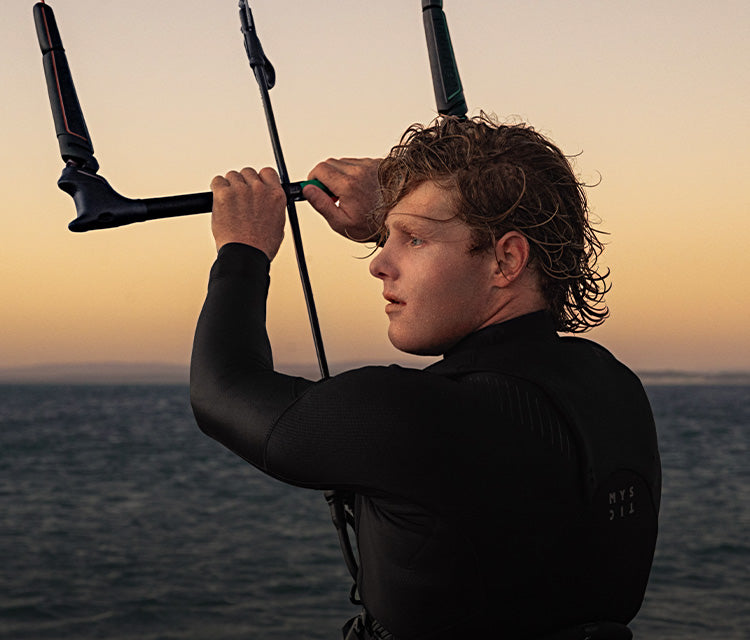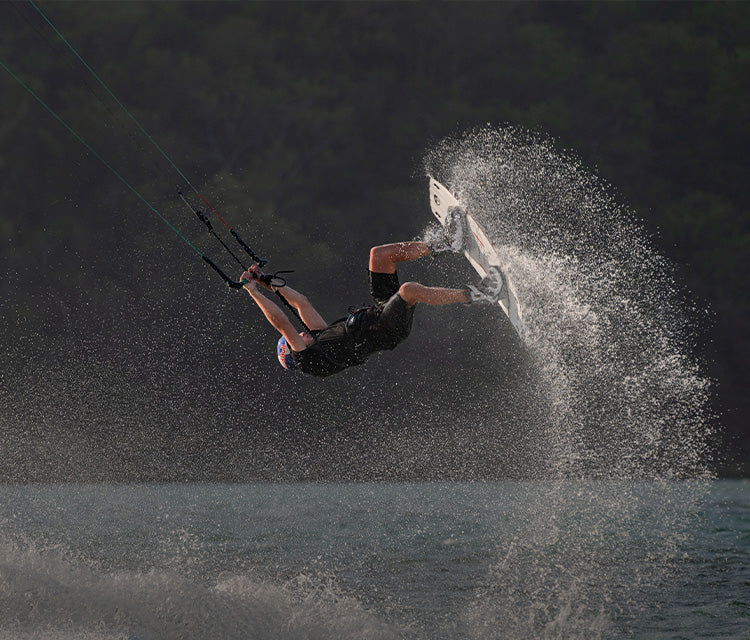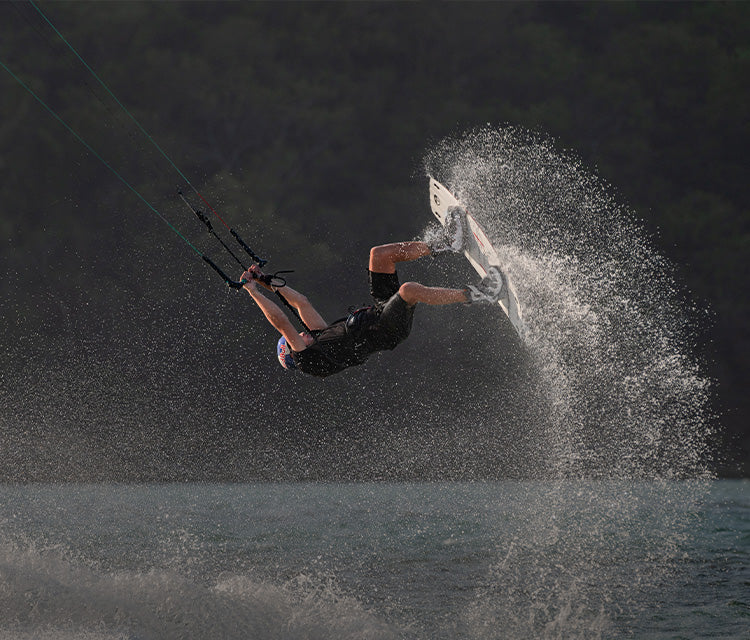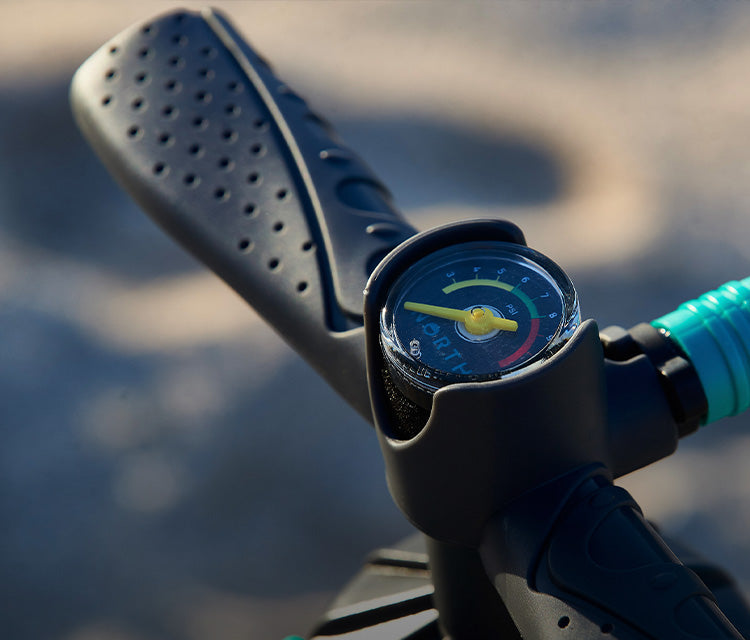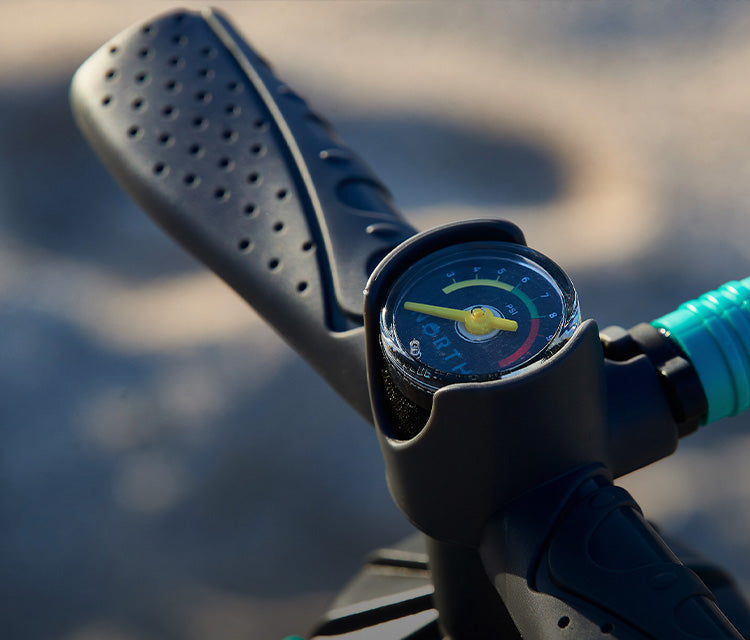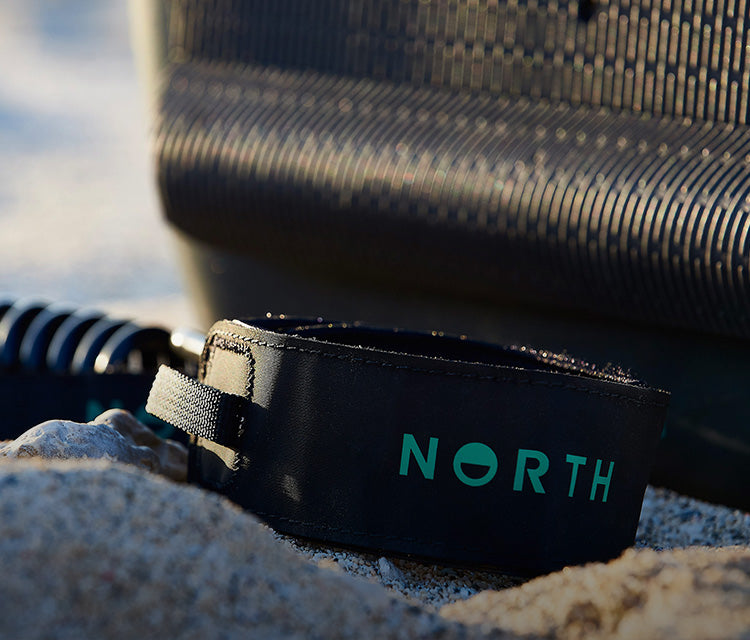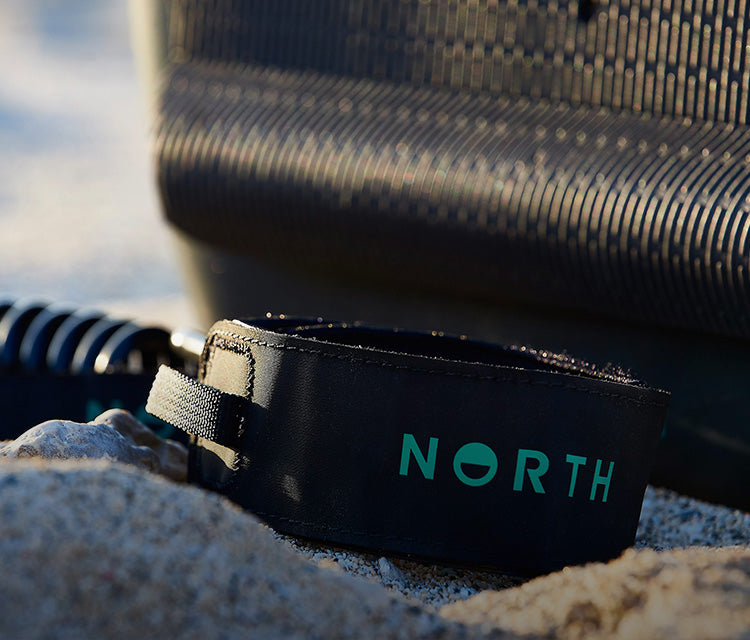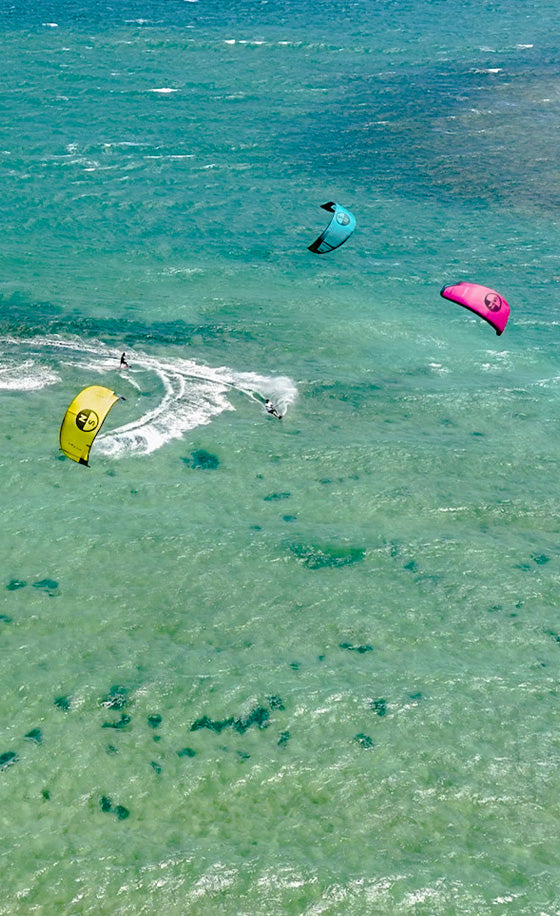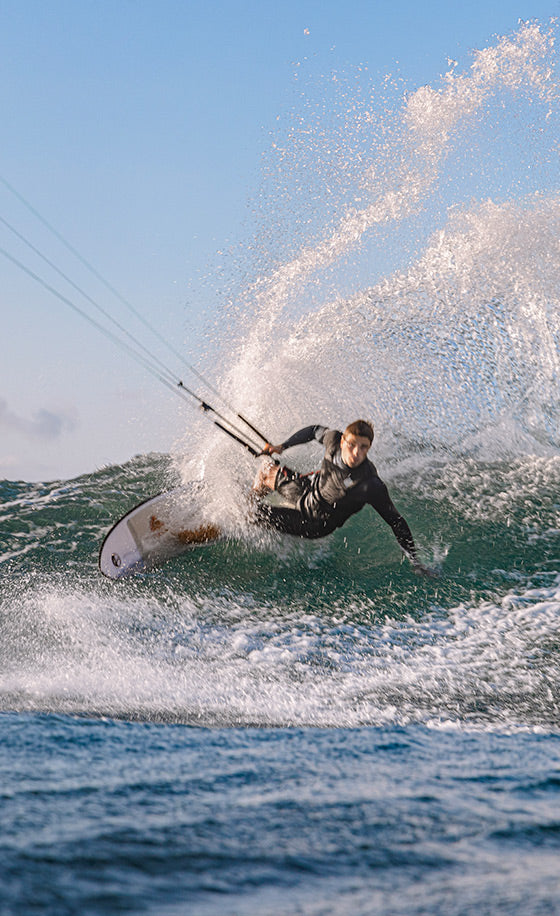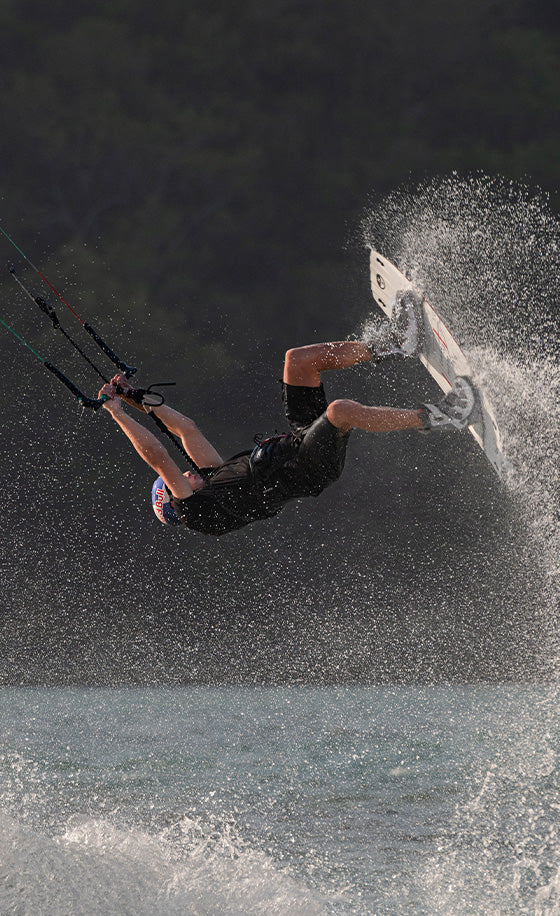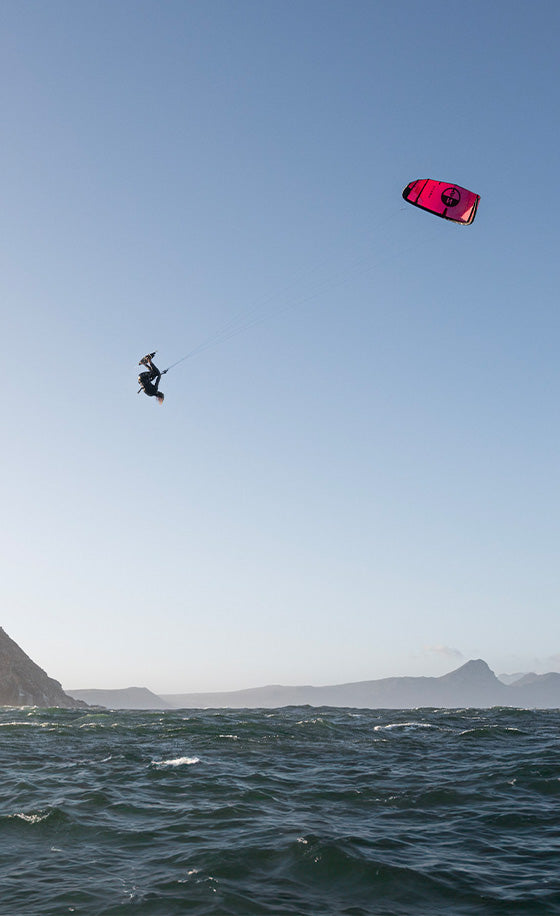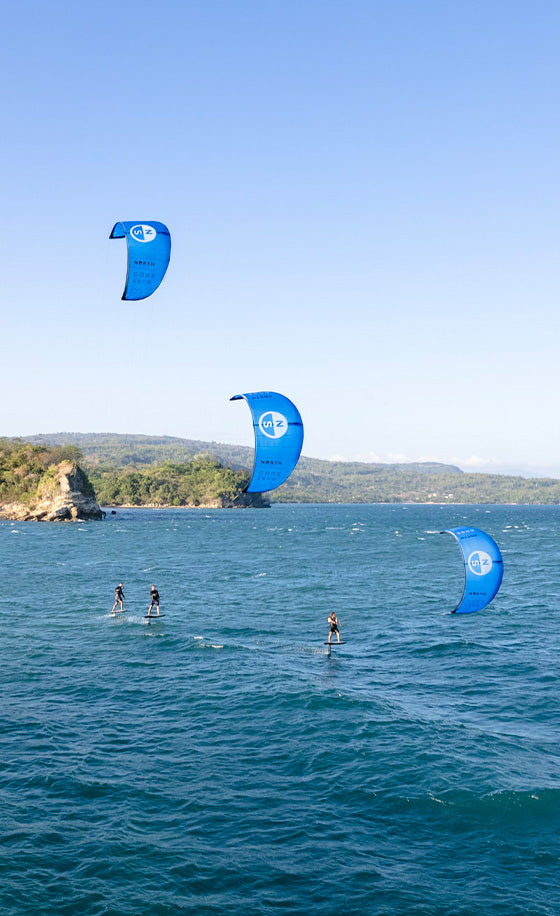
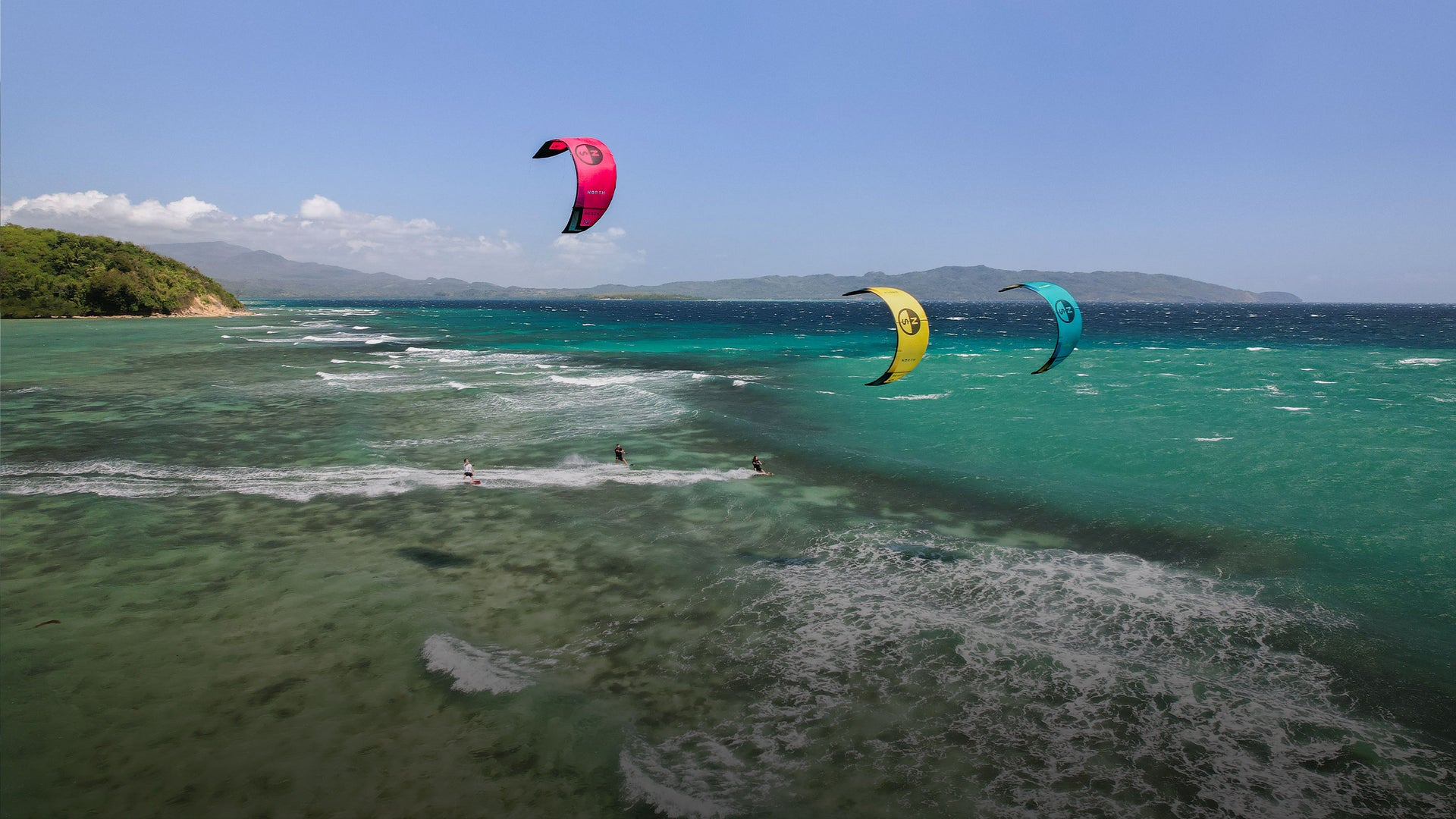
The Complete Guide
to Kitesurfing for Beginners
1. Introduction
Kitesurfing, also known as kiteboarding, is a wind-powered water sport that combines aspects of board sports like surfing, wakeboarding, and snowboarding. Kitesurfers use a specially designed kite and a board to ride on the water, propelled by the wind. Kitesurfing can be done in a variety of water conditions, from flat water to waves, and requires skill and practice to master. It’s a popular sport among adrenaline junkies and those looking for an exciting way to enjoy the wind and water.
If you’re interested in learning how to kitesurf, or simply looking for a little more info on anything related to kitesurfing – you’ve come to the right place. In this beginner’s guide, we will cover everything you need to know to start kitesurfing.
Overview
Ready to take a deep dive into anything and everything kitesurfing? Check out the overview of the beginner’s guide below. Feel free to head directly to the section that’s most relevant to you.
Table of Contents
2. Basics of Kitesurfing
3. Kitesurfing Equipment
4. Learning to Fly a Kite
5. Kitesurfing Lessons
6. Kitesurfing Disciplines
7. Commonly Asked Questions about Kitesurfing
8. Conclusion
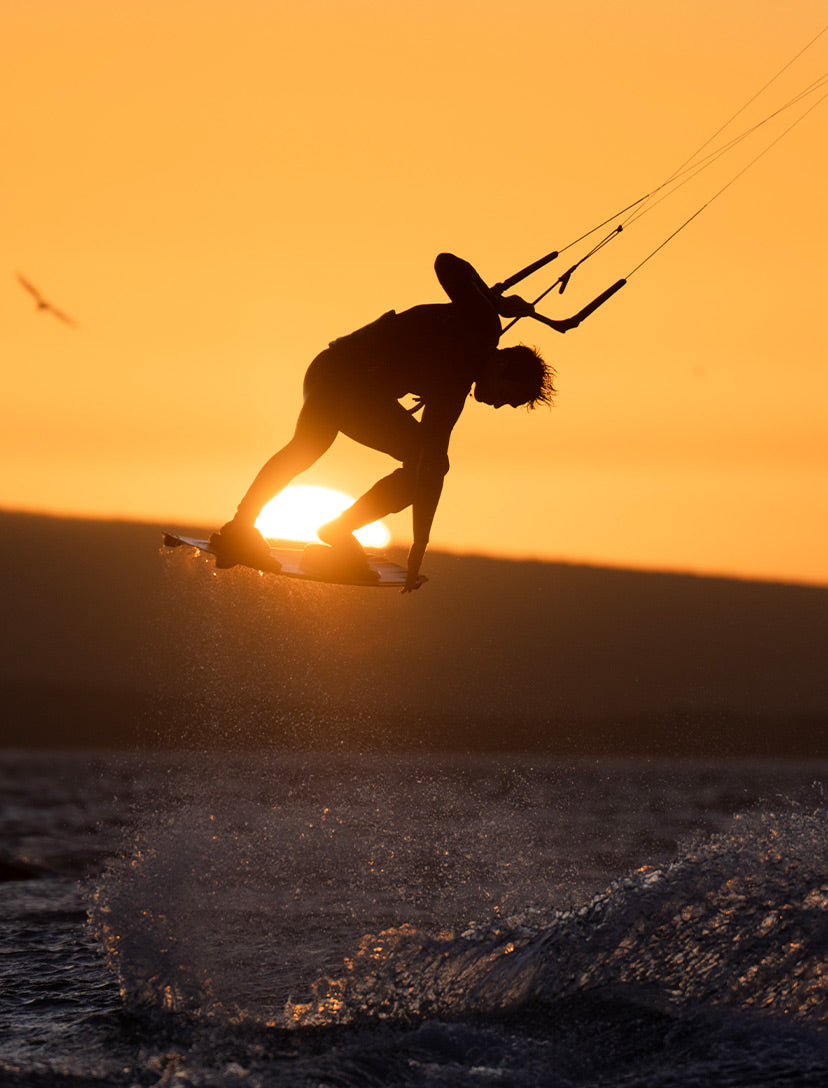
2. Basics of Kitesurfing
What is kitesurfing?
Kitesurfing is an exciting water sport that combines elements of both wind sports and board sports. It involves the use of a large, specially designed kite that is attached to a rider via a harness, allowing them to harness the power of the wind to propel themselves across the water on a board.
In kitesurfing, the board is similar to a wakeboard, surfboard or snowboard, depending on the conditions and the rider’s preferences. The kite, which is typically made of lightweight materials like nylon or polyester, is attached to the rider’s harness via a control bar that allows them to steer and control the kite’s movements.
Contrary to popular belief, kitesurfing is not as difficult as it seems, and anyone can learn to do it with the right instruction and equipment. It can be done in a variety of water conditions, from calm, flat lakes to choppy, windy oceans, making it a versatile water sport that can be enjoyed by people of all skill levels. That said, kitesurfing can be both challenging and thrilling, and is a sport that requires skill, strength, and a good understanding of wind and weather conditions.
What is the difference between kitesurfing and kiteboarding?
Kitesurfing and kiteboarding are often used interchangeably to refer to the same sport. On a technical level, we would say that the two terms can refer to different styles of riding. Kiteboarding refers to the use of a kite to propel a rider on a board over water. Kitesurfing, on the other hand, can refer to a style that involves riding waves in the ocean while using a kite for propulsion. We prefer to just use the terms interchangeably. In this article, we’ll mostly be using the term ‘kitesurfing’, and when we do, we’re referring to the sport as a whole.
Understanding wind conditions and wind direction
Understanding wind conditions and direction is essential for kitesurfing. Wind conditions, which can vary from light to strong, affect kite size and board selection. Wind direction, on the other hand, determines which direction to ride in and can vary based on the location. In Cape Town, for instance, the infamous “Cape Doctor” wind blows from the southeast, providing ideal conditions for kitesurfing. It’s important to also consider local beach conditions, which can affect the strength and direction of the wind.
To learn more about how wind conditions affect kite choice, head to "How to choose the right kite size" below.
Equipment required for kitesurfing
Kitesurfing requires specific equipment to ensure safety and enjoyment on the water. The main pieces of gear include a kite, pump, control bar, lines, harness, spreaderbar, board, board bindings, waterwear, and safety gear. It’s important to choose equipment that is appropriate for your level of experience and the conditions you’ll be riding in. For those new to the sport, it’s recommended to take lessons from a qualified instructor who can guide you in selecting gear and using it safely. Additionally, purchasing new gear may be necessary as you progress and require different kite sizes or other equipment. Investing in your own gear is more cost-effective than renting, depending on how frequently you’ll go kiting. In the next section, we’ll take a deep dive into the equipment you need to start kitesurfing. But first, we’ll cover safety.
STARTER KIT NORTH KITEBOARDING
Importance of Safety
Safety Equipment
Kitesurfing involves the use of safety equipment, which is crucial for the safety of the rider and those around them. A safety system typically includes a safety leash, which attaches the kitesurfer to the control bar, and a safety release system, which allows the rider to quickly release the kite in emergency situations. In addition, wearing a helmet, impact vest, and properly fitting harness is essential to protect against head injuries and prevent the harness from riding up. These safety equipment pieces can prevent serious accidents such as being dragged by a kite or being lofted into the air, ultimately ensuring a safe and enjoyable kitesurfing experience.
Rules of Priority in Kitesurfing
In kitesurfing, there are rules of priority that determine who has the right of way in different situations. These rules are important to ensure the safety of all kitesurfers on the water. Here are the basic rules of priority in kitesurfing:
1. The rider entering the water has priority over the incoming rider.
2. The starboard rider (riding with the kite on the right-hand side) has priority over the oncoming rider and should keep their course.
3. When two riders are traveling in the same direction, the faster rider must give way to the slower rider in the front.
4. The rider surfing a wave has priority over anyone who is jumping or going in the opposite direction.
5. Right of way must be given to other ocean and beach users. Kitesurfers must travel downwind of them.
It’s important to always be aware of your surroundings and other kitesurfers on the water. Don’t assume that other kitesurfers are aware of the rules of priority, so communicate clearly and give way if necessary. Remember that safety should always be your top priority when kitesurfing.
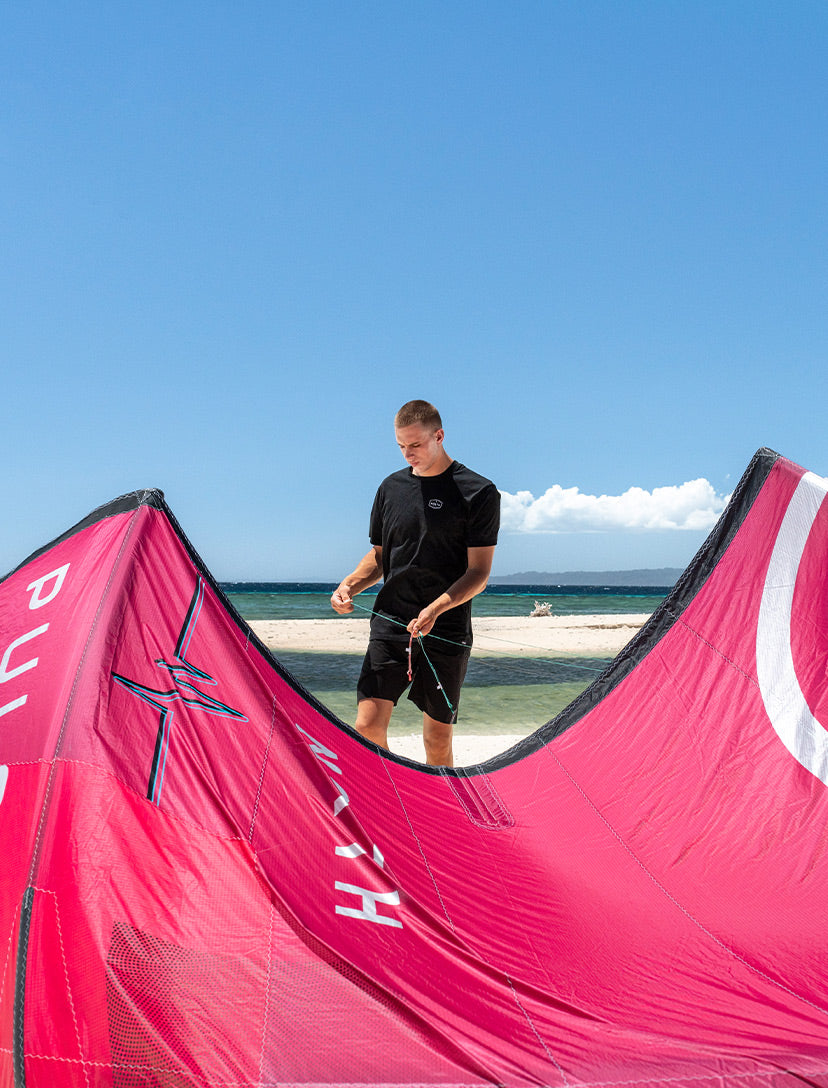
3. Kitesurfing Equipment
Kitesurfing Equipment Overview
Below is an overview of the essential kitesurfing equipment:
Kite
The kite is the most crucial piece of equipment in kitesurfing. It is typically made of ripstop nylon and has an inflatable leading edge to keep its shape. Different kites come in different shapes, sizes, and designs, depending on the rider’s skill level and preferred riding style.
Control bar
The control bar is the rider’s connection to the kite. It allows the rider to control the kite’s power and direction by pulling or releasing the lines. The control bar typically has a chicken loop that attaches to the harness.
Lines
The lines connect the kite to the control bar. They are typically made of Dyneema or another high-strength material and come in different lengths.
Harness
The harness is a waist or seat harness worn by the rider. It distributes the kite’s pull across the rider’s body, reducing fatigue and allowing for more extended sessions.
Spreaderbar
A spreader bar is a piece of equipment used in kitesurfing that connects the rider’s harness to the kite. It helps distribute the pull of the kite across the rider’s body, reducing the strain on the arms and allowing for better control. It also allows the rider to hook and unhook the kite quickly and easily in case of an emergency.
Board
The board is what the rider stands on while being pulled by the kite. Kitesurfing boards come in various shapes and sizes, depending on the rider’s skill level, riding style, and water conditions.
Waterwear
In general, a wetsuit is recommended for kitesurfing in colder water temperatures to keep you warm. You may also need neoprene boots, gloves, and a hood. In warmer water temperatures, you may not need a wetsuit, but it’s still a good idea to wear a rash guard or other protective clothing to protect your skin from sunburn and abrasions.
Safety gear
For your first couple of kitesurfing experiences, safety gear is essential to protect you in case you wipeout. The gear includes a safety leash, helmet, and impact vest. Note that once riders get the hang of kitesurfing, or they’ve completed their lessons and are now comfortable riding on their own, many choose to go without helmets and impact vests.
Pump
The pump is used to inflate the kite’s leading edge before use.
Accessories
Other accessories that can be useful in kitesurfing include board leash, footstraps, fins, and a kite bag for storage and transport.
It’s important to note that kitesurfing equipment can vary depending on the rider’s preferences and the specific conditions they’ll be kitesurfing in. It’s crucial to choose the right equipment for your skill level and the conditions you’ll be riding in to ensure your safety and enjoyment. Keep reading to find out more about choosing the right equipment as a beginner.
Types of Kitesurfing Kites
Kitesurfing kites come in different types, including inflatable leading edge, foil, and c-kites. Most kites come in different sizes, allowing riders to choose the appropriate kite based on wind conditions and their skill level.
Inflatable Kites
As a beginner, it’s recommended to start with an inflatable leading edge kite. These kites are the most common and ideal for beginners because they are easy to relaunch, offer stable and predictable flight, and provide a forgiving feel. Inflatable kites also offer good depower, which means they can reduce their power output in strong winds, making them safer and easier to handle for beginners.
Foil Kites
Foil kites are non-inflatable kites that use a series of cells filled with air to maintain their shape. These kites can generate more power than inflatable kites and are popular among experienced riders.
C-kites
C-kites, also known as classic kites, are characterized by their C-shaped arc and offer a more direct and responsive feel. They were once the predominant choice in kitesurfing, but these days it’s a niche, only used by some experienced freestyle riders. If you’re up for a challenge you could certainly explore C-kites, but if you’re a beginner, we’d recommend sticking to inflatable kites due to their ease of use, versatility, and safety features.
How to choose the right kite size
Kitesurfing kite sizes are typically measured in square meters (m²) of the kite’s surface area. The kite’s size is an essential factor to consider when selecting the appropriate kite for your skill level, body weight, wind conditions, and riding style. you’d typically choose a smaller kite for strong wind, and larger kite for light wind. Furthermore, larger kites produce more lift, power, and have a greater wind range, while smaller kites are more maneuverable and easier to control. As a beginner, it’s generally better to start with a larger kite anyway, which will make it easier to get up on the board and start riding.
Another factor to consider in choosing the right kite size is your board type or riding style. Riders on directional boards, such as those used for wave riding, experience less drag and therefore might opt for smaller kites to maintain a faster speed compared to those on twip tip boards.
Types of Kitesurfing Harnesses
There are two main types of kitesurfing harnesses: waist harnesses and seat harnesses. It’s important to choose a harness that fits well and is comfortable to wear for extended periods to prevent fatigue and ensure a safe and enjoyable kitesurfing experience.
Seat Harness
A seat harness is the ideal kitesurfing harness for beginners. A seat harness comes with pre-shaped seat cups and leg straps that easily and more comfortably holds down power from your kite. When you’re a beginner, your kite tends to stay overhead, creating an upwards pull. Part of your progression as a beginner is learning how to ride with a kite in a lower position, so the kite ultimately gives you less of an upwards pull.
Waist Harness
Many beginners purchase a waist harness as their first harness, which is a good idea if you want to invest in long-term gear. From the moment you’ve had lessons with a seat harness at your local kite school, the learning curve is steep. In this case, a waist harness sits higher up than a seat harness and offers you more freedom of movement. For waist harnesses, you can choose between a softshell or hardshell design.
Importance of kite lines and steering lines
Kite lines and steering lines are essential components of kitesurfing equipment.
Kite lines attach the kite to the kitesurfing bar, which is used to control the kite's power and direction. The kite lines are responsible for transmitting the force generated by the kite to the rider, allowing them to harness the wind's power and ride the board. They come in different lengths and strengths, depending on the size and power of the kite.
Steering lines, on the other hand, are the lines that attach the kite to the rider's harness. They are responsible for controlling the kite's direction and angle of attack, which determines the amount of power the kite generates. By pulling on the steering lines, the rider can make the kite turn left or right and adjust its position in the wind window.
Types of kitesurfing boards
Twin-Tip
This is the most popular type of kitesurfing board and is suitable for all-around riding. It has a symmetrical shape, with fins on both ends, and is designed for riding in both directions. Twin-tip boards are easy to ride and offer good control and stability, making them an ideal choice for beginners.
Directional
This type of board is shaped like a surfboard and is designed for riding waves. Directional boards have a pointed nose and are usually longer and narrower than twin-tip boards. They are best suited for experienced riders who want to challenge themselves in more advanced conditions.
Foil
Foil boards have a hydrofoil attached to the bottom of the board, which lifts the board out of the water and reduces drag. Foil boards can ride in much lighter wind conditions than other boards, making them a great choice for light wind days. However, they require more skill and experience to ride than other types of boards.
Wakestyle
Wakestyle boards are designed for advanced freestyle riding, including jumps and tricks. They have a stiffer flex, a flat rocker, and wider stance options for better pop and control.
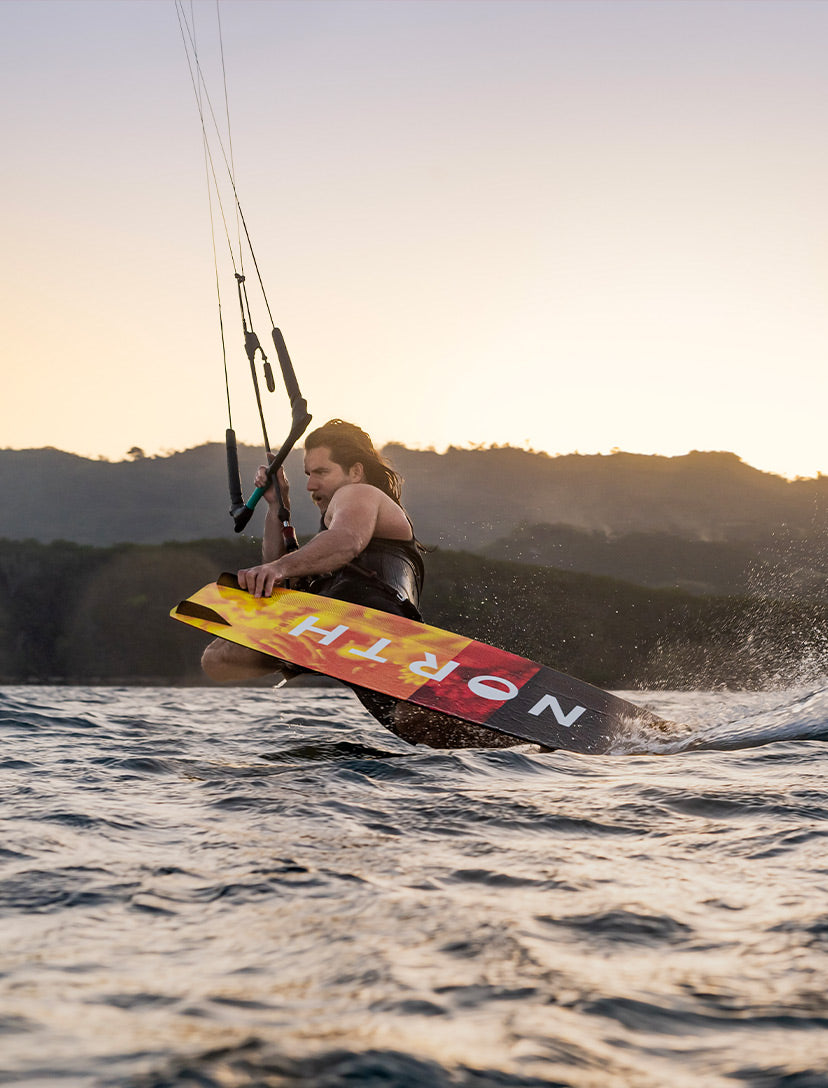
4. Learning to Fly a Kite
Importance of Kite Flying Skills
Kite flying skills are essential for kitesurfing, and they involve learning to control the kite with the control bar. Beginner kitesurfers typically need to practice kite flying multiple times to develop the necessary skills to progress to riding. Even experienced kitesurfers fly their kites before hitting the water to assess wind conditions and warm up. Developing proper kite flying skills is crucial for a safe and enjoyable kitesurfing experience.
Understanding the Wind Window
So you’ve got your new kite – well, you can’t really fly it without any wind! Understanding the wind window and wind direction is crucial for kitesurfing effectively. The wind window is the three-dimensional space in front of the rider where the kite can be flown. The wind window is divided into two parts: the power zone and the edge of the window. The power zone is where the kite generates the most power, while the edge of the window is where the kite generates the least power. The rider needs to understand how to control the kite within the wind window to generate power and lift to ride the board. Wind direction is also important because it affects the kite’s flight path and the rider’s ability to ride in one direction.
Benefit of the Trainer Kite
Using a trainer kite for practice is highly beneficial for beginners learning to kitesurf. A trainer kite is a small, lightweight kite that’s designed to teach the basics of kite control, including launching, landing, steering, and power control. Using a trainer kite allows beginners to practice in a safe, controlled environment, without the risk of being pulled into the water. It also allows beginners to develop their kite control skills before moving onto a full-sized kite. Practicing with a trainer kite can help build confidence, improve muscle memory, and reduce the learning curve when it comes to learning to kitesurf with a full-sized kite.
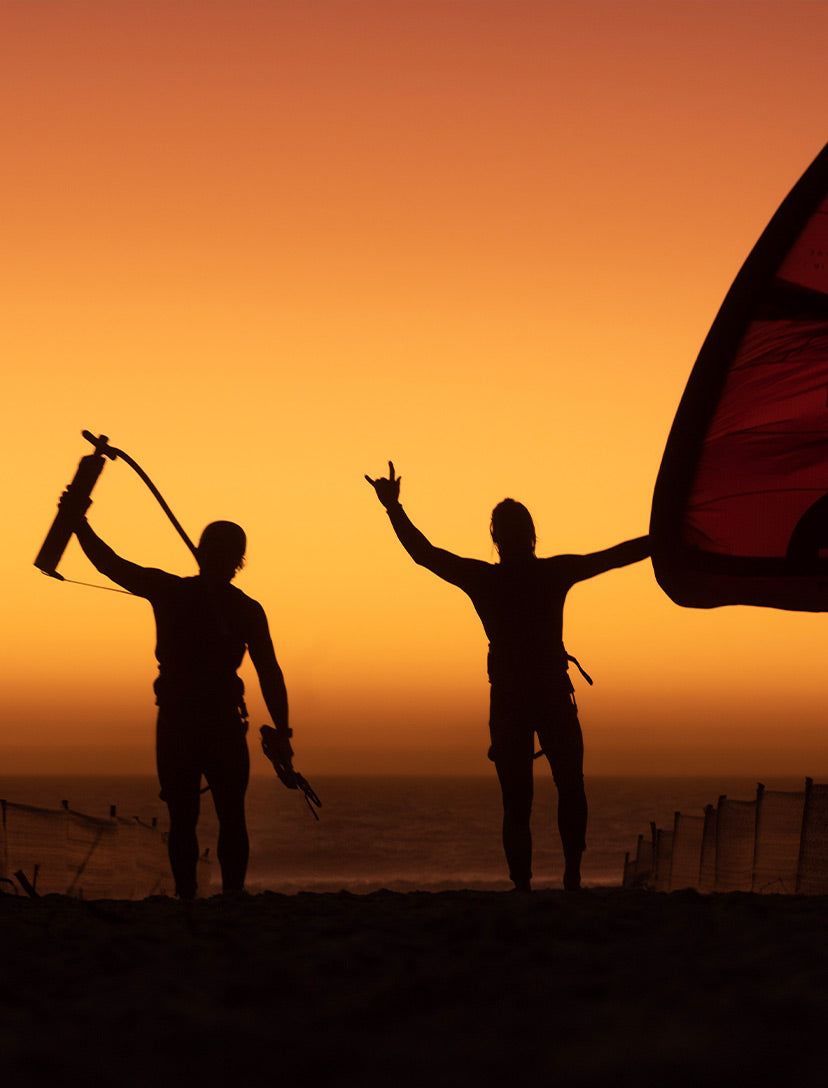
5. Kitesurfing Lessons
Taking lessons from a qualified instructor
Taking lessons from a qualified instructor is extremely important when learning to kitesurf. Kitesurfing involves using powerful equipment in a constantly changing environment, which can be dangerous for beginners who are not familiar with the sport. A qualified instructor can teach you how to kitesurf safely and effectively. They can also provide guidance on reading weather conditions, selecting the right equipment, and making smart decisions while out on the water.
What to expect from beginner lessons
At a beginner level in a kitesurf school, you can expect to learn the basics of kite control, body positioning, and board control. Lessons will typically start with an introduction to the equipment, including how to set up and launch the kite, as well as important safety procedures. You will then progress to learning how to fly a trainer kite, which is a smaller, less powerful kite used for teaching kite control on land. Once you have mastered the basics of kite control with the trainer kite, you will move on to learning how to use a full-sized kitesurfing kite in the water. You will learn how to launch and land the kite, control its power, and control your body position and board direction. Throughout your lessons, your instructor will provide feedback and guidance to help you progress at your own pace and build confidence in the sport.
The learning process of kitesurfing
Learning to kitesurf is a fun and exciting process that can take several weeks or months to master, depending on your dedication and the quality of instruction you receive. Here is a general overview of what the learning process of kitesurfing is like:
Introduction and Safety
Before getting on the water, it’s important to learn the basics of kite control and safety. This includes understanding wind conditions and direction, learning how to properly set up and launch a kite, how to control the power of the kite using the bar, and how to perform emergency procedures such as self-rescue.
Body Dragging
Once you have mastered the basics of kite control, the next step is to learn how to body drag. This involves using the power of the kite to pull yourself through the water without a board. Body dragging helps you develop a feel for the wind and water and is an essential skill for getting back to your board if you lose it while riding.
Board Skills
After you’ve mastered body dragging, it’s time to learn how to ride the board. This involves getting up on the board and riding in both directions. The key to successful riding is to maintain proper kite control and body position while carving back and forth.
Relaunch Techniques
Re-launching a kite is an important skill in kitesurfing as crashes and losing control are a normal part of learning and practicing. The most common relaunch techniques include the “downwind” method, where the rider pulls on one of the back lines to flip the kite over and restart it, and the “upwind” method, where the rider walks the kite upwind while pulling on one of the front lines to relaunch it.
Riding Upwind
Once you’ve mastered basic board skills, the next step is to learn how to ride upwind. This involves using your board and kite to sail upwind, allowing you to travel long distances and explore different parts of the water.
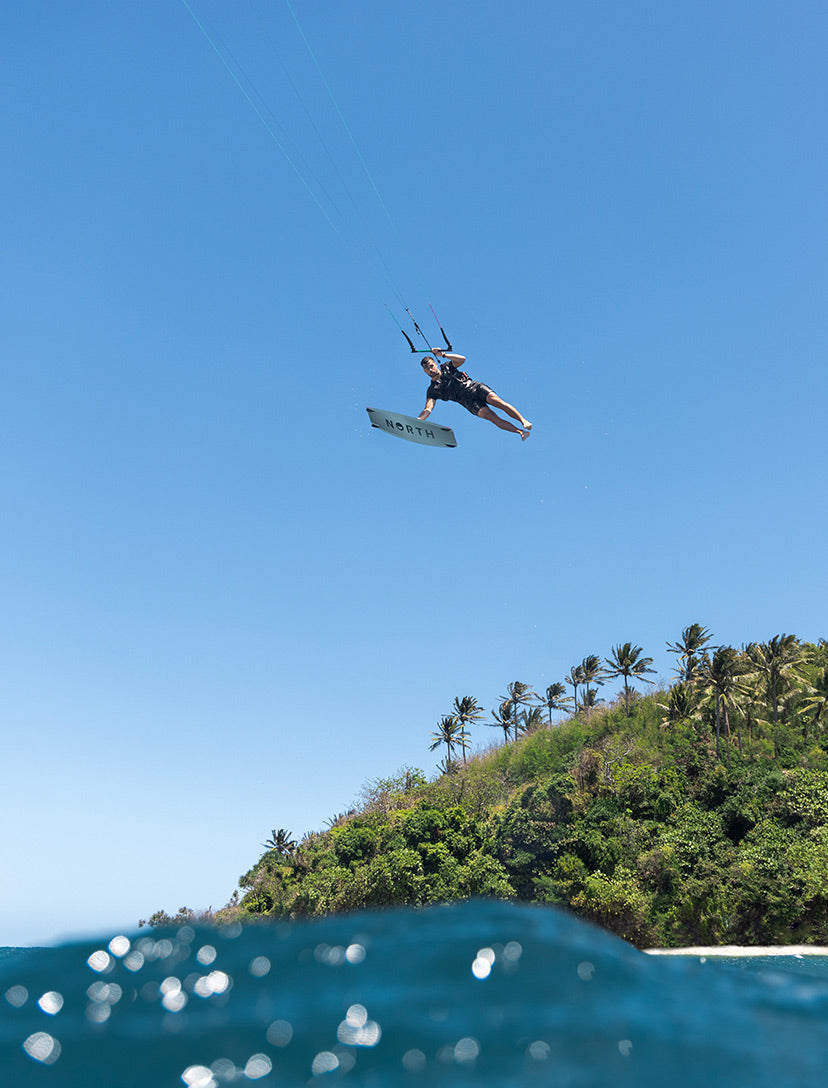
Tricks and Advanced Techniques
Finally, once you’ve mastered the basics of kitesurfing, you can start to explore more advanced techniques and tricks, such as jumping, looping, and freestyle riding.
The steep learning curve and how to overcome it
Overcoming the steep learning curve in kitesurfing requires a combination of proper training, equipment, practice, and patience. Here are some tips to help you progress quickly and safely:
Get Proper Training
A good instructor can help you learn the basics of kite control and body position, and can provide you with valuable feedback on your progress. This may mean switching schools if you’re not happy with your current one.
Invest in Quality Equipment
Having the right equipment is essential for learning to kitesurf. Make sure you have a kite, board, and harness that are appropriate for your skill level and the conditions you will be kiting in. High-quality gear will help you progress quickly.
Practice Regularly
Like any sport, kitesurfing requires practice to improve your skills. Try to kite as often as possible, and make sure you set goals for yourself to work towards. This will help you stay motivated and focused on your progress.
Be Patient
Kitesurfing is a complex sport that takes time to master. Don't get discouraged if you're not progressing as quickly as you'd like. Remember that everyone learns at their own pace, and that mistakes are a natural part of the learning process.
Focus on Safety
Kitesurfing can be a dangerous sport if proper safety measures are not taken. Always prioritize safety by wearing a helmet and impact vest, checking wind and weather conditions, and staying within your skill level.
Connect with Other Kiters
Joining a local kitesurfing community or connecting with other kiters online can be a great way to learn from others and get tips on improving your skills. You may also find it motivating to kite with others who are at a similar skill level.
Common mistakes to avoid
Remember that mistakes are a natural part of the learning process. However, there are common mistakes that beginners tend to make. Avoiding these could help you progress quicker. Here are some common mistakes that beginners make in kitesurfing:
Underestimating the power of the kite
The kite generates a lot of power, and beginners often underestimate this power. It's important to learn how to control the kite properly and use the right kite size for your skill level.
Not checking weather and wind conditions
Kitesurfing requires specific wind conditions. Beginners often make the mistake of not checking the weather forecast or not choosing the right equipment according to the wind conditions. Remember, different locations can have drastically different conditions!
Not practicing enough
Kitesurfing requires a lot of practice to master. Beginners often make the mistake of not practicing enough or trying to progress too quickly.
Not respecting other riders or water users
Kitesurfing can be a dangerous sport if you don’t respect the basic rules of priority in kitesurfing, or pay attention to other water users like swimmers, surfers, or boats.
Focusing too much on the board
Beginners often make the mistake of focusing too much on the board and not enough on the kite. It's important to learn how to control the kite first and then focus on the board.
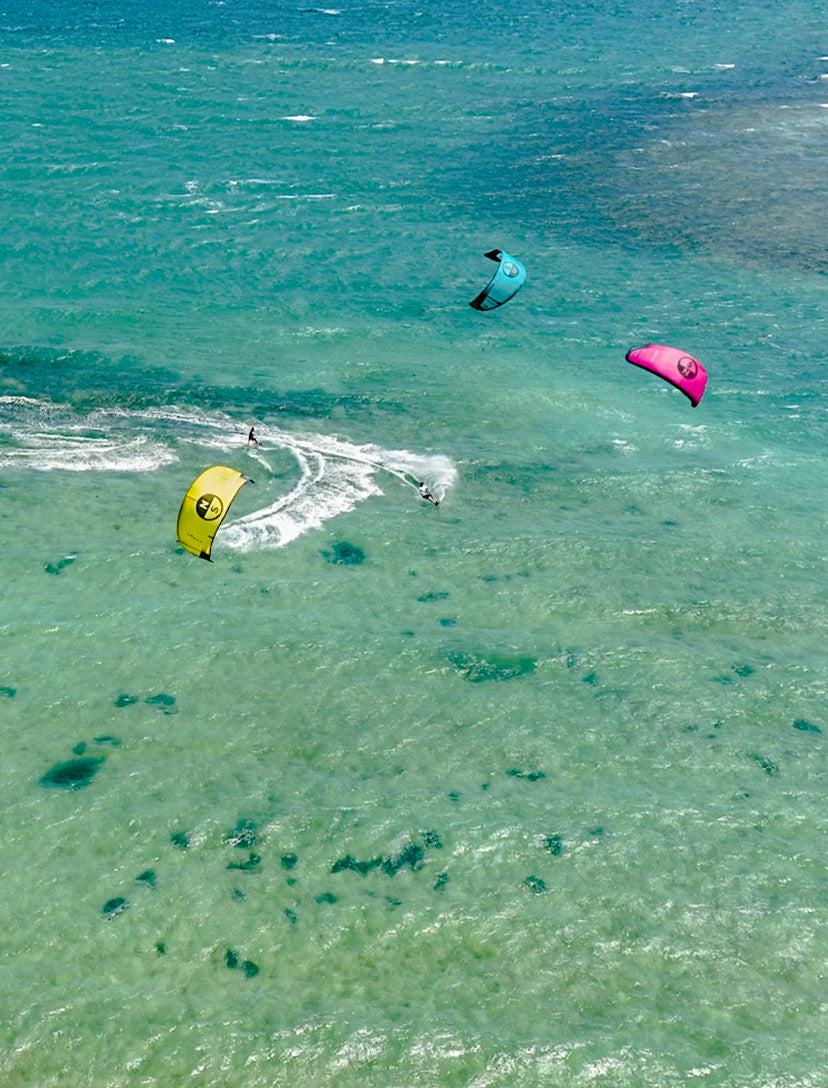
6. Kitesurfing Disciplines
Kitesurfing is a versatile sport that offers various disciplines, each with its own unique style and challenges. It’s one of the things that keeps it most interesting, with different avenues to explore for each rider. Here are some of the most common kitesurfing disciplines:
Freeride
This is the most common discipline of kitesurfing, where the goal is to ride the waves and perform jumps and tricks. It’s all about having fun and exploring new areas with your kite.
Wave riding
Wave riding is all about surfing the waves and using the power of the kite to help you navigate. It requires good board control and the ability to read the waves to catch the best rides. This is arguably the discipline a lot of surfers opt for, seeing as the common goal is to catch as many waves as possible. The difference is, of course, you’ve got a kite to help propel you into the waves and back.
Freestyle
Freestyle kitesurfing is all about performing tricks and jumps. It involves a lot of aerial maneuvers, such as grabs, rotations, and flips. The goal is to be as creative as possible and show off your skills.
Big Air
Big air involves performing the biggest and most impressive jumps possible. It requires a lot of speed, control, and timing, and sometimes involves jumping over obstacles.
Foilboarding
Foilboarding is a newer discipline that involves riding a hydrofoil board, which lifts the rider above the water surface. It requires good balance and control, and allows for high speeds and long rides.
Racing
Kite racing involves riding around a course as fast as possible. It requires good speed and maneuverability, and often involves tactics such as tacking and gybing to gain an advantage over other riders.
7. Commonly Asked Questions about Kitesurfing
Is it easy or hard to learn how to kitesurf?
The difficulty level of learning kitesurfing depends on a few factors such as your previous experience with other board sports like skateboarding, snowboarding or wakeboarding, your level of physical fitness, and your ability to understand and follow instructions.
Can I teach myself to kitesurf?
In theory, yes, but this isn’t recommended. The process will be a lot easier, safer, and even quicker if you take lessons from a certified kitesurfing instructor who can teach you the proper techniques for kite control, board skills, and safety procedures.
How long does it take to learn how to kitesurf?
You can’t expect to learn how to kitesurf in a day. On your first day of lessons, you may get the hang of flying a trainer kite, but you can’t expect to learn all the other skills necessary for kitesurfing, like kite control, and board skills. With practice and perseverance, you can become a proficient kitesurfer, but it may take some time to get comfortable with the sport and reach an advanced level.
Is kitesurfing harder than surfing?
Kitesurfing requires you to control the kite, board, and wind all at the same time, which can be challenging for beginners. Surfing, on the other hand, requires good balance, timing, and positioning on the board to catch and ride waves. Both sports have their own unique challenges and rewards, and it really depends on the individual’s skill level, experience, and preference.
How do I start kitesurfing?
To start kitesurfing, it’s recommended to take lessons from a qualified instructor and get the right gear. You should practice kite control and board skills, and always follow safety procedures. Joining a local kitesurfing community can also be helpful for learning and discovering new spots.
What gear do I need to start kitesurfing?
To start kitesurfing, you need to buy the right gear. We’ve created a list for this below, which includes our personal recommendations for beginners. Don’t hesitate to reach out to our team for further advice.
Mystic starter Kit
- Seat Harness (spreaderbar included)
- or Waist Harness, depending on your budget – Men: Warrior X, Majestic, Majestic X or Stealth Women: Dazzled, Gem
- Spreaderbar
- Safety leash
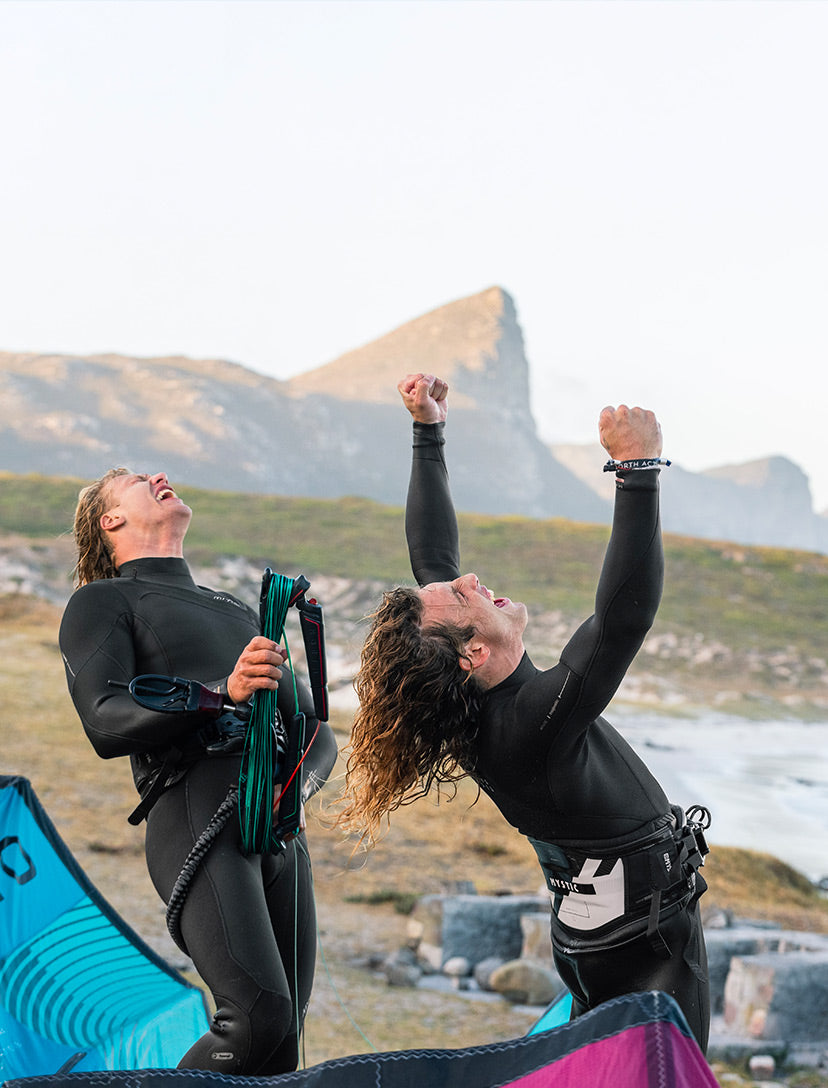
8. Conclusion
In conclusion, kitesurfing is an exciting and rewarding water sport that requires practice, patience, and dedication to master. With the right equipment, training, and guidance, anyone can learn how to kitesurf and enjoy the thrill it offers. If you are interested in learning how to kitesurf, we recommend starting by finding a reputable kitesurfing school near you, and watching instructional kitesurfing videos so you know what to expect. Remember to always prioritize safety, follow proper techniques, and have fun out on the water. Happy kitesurfing!
